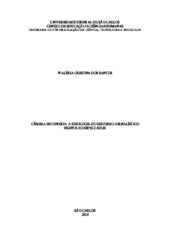| dc.contributor.author | Santos, Waléria Cristina dos | |
| dc.date.accessioned | 2016-06-02T19:16:29Z | |
| dc.date.available | 2011-11-01 | |
| dc.date.available | 2016-06-02T19:16:29Z | |
| dc.date.issued | 2011-02-24 | |
| dc.identifier.citation | SANTOS, Waléria Cristina dos. Câmera escondida: a ideologia do discurso jornalístico frente ao espectador. 2011. 107 f. Dissertação (Mestrado em Multidisciplinar) - Universidade Federal de São Carlos, São Carlos, 2011. | por |
| dc.identifier.uri | https://repositorio.ufscar.br/handle/ufscar/1070 | |
| dc.description.abstract | The hidden camera has been constantly utilized in televised journals as a tool to acquire the news being broadcast. What no one takes into consideration is how the spectators feel about this type of attitude coming from the journalists. This research's objective is to analyze the way in which the spectator attributes meaning to the televised reports obtained through the use of the hidden camera. Therefore, it was taken into consideration factors such as the ideological character of both the broadcaster, responsible for broadcasting the story, with it's news production routines, as well as the journalist itself, who elaborates the story and it's inter-relation with the spectator. The discussion begins with subjects such as genders of speech and the ideology of journalistic speech narrowing down into investigative journalism, for the understanding that it is within' this gender that he journalists make use of hidden cameras. The question that rises is that in the intent of showing the story the journalist drifts away from more ethical approaches, not minding the consequences but merely the impact of the story, using the journalistic fact to intensify the individual appearing in front of the camera as a contraventor. At first this focus shift from the fact to the subject in hand can generate certain sensationalism and destitute the spectator of its right to be in contact with the true message the story should be focusing on. To develop the proposed questions this study was fundamented under the optic of the theorist Mikhail Bakhtin, who discusses the language under the social interactionist perspective and allows us, through his studies, to work with themes such as society, ideology, ethics and aesthetics, and above all, the way the subject interacts with these speeches. Therefore, two televised stories obtained with the use of hidden cameras were utilized, which have been broadcast in televised journals on TV Globo and that were presented to the interviewed subjects. Their answers were of utmost importance, since they allowed the reflection about the subject as well as some important factors. | eng |
| dc.format | application/pdf | por |
| dc.language | por | por |
| dc.publisher | Universidade Federal de São Carlos | por |
| dc.rights | Acesso Aberto | por |
| dc.subject | Análise do discurso | por |
| dc.subject | Jornalismo | por |
| dc.subject | Ideologia | por |
| dc.subject | Dialogismo | por |
| dc.subject | Câmera escondida | por |
| dc.subject | Televisão | por |
| dc.subject | Journalism | eng |
| dc.subject | Ideology | eng |
| dc.subject | Dialogism | eng |
| dc.subject | Hidden camera | eng |
| dc.subject | Television | eng |
| dc.title | Câmera escondida: a ideologia do discurso jornalístico frente ao espectador | por |
| dc.type | Dissertação | por |
| dc.contributor.advisor1 | Miotello, Valdemir | |
| dc.contributor.advisor1Lattes | http://lattes.cnpq.br/9131819326282708 | por |
| dc.description.resumo | A Câmera escondida tem sido utilizada constantemente em telejornais como ferramenta de apreensão da notícia que será veiculada. O que ninguém leva em consideração é como o espectador absorve este tipo de atitude que parte do jornalista. Esta pesquisa teve como objetivo analisar a maneira pela qual o espectador atribui significação às reportagens televisivas obtidas por meio da ferramenta câmera escondida. E, para tanto, levou-se em consideração fatores como o caráter ideológico tanto da emissora, veículo que transmite a matéria, com suas rotinas de produção da notícia, quanto do próprio jornalista que elabora a reportagem e sua inter-relação com o espectador. A discussão tem como ponto de partida temas como gêneros do discurso e a ideologia do discurso jornalístico afunilando para o jornalismo investigativo, por entender que é dentro deste gênero que o jornalista faz uso de câmeras escondidas. A questão que surge é que na intenção de mostrar a notícia o jornalista afaste-se dos meios éticos não se importando com conseqüências, mas apenas com o impacto da reportagem, colocando o fato jornalístico para intensificar o indivíduo que aparece na frente da câmera como um contraventor. A princípio essa mudança de foco que deixa de olhar o fato e passa a ter o sujeito em primeiro plano pode gerar certo sensacionalismo e fazer com que o espectador seja destituído do direito de receber a verdadeira mensagem que a reportagem deveria se propor. Para desenvolver as questões propostas o estudo foi fundamentado sob a ótica do teórico Mikhail Bakhtin que discute a linguagem sob a perspectiva sócio interacionista e que nos permite, por meio de seus estudos, trabalhar com temas como a sociedade, ideologia, ética e estética, e sobretudo, pela maneira como o sujeito interage com esses discursos. Para tanto, foram utilizadas duas reportagens televisivas obtidas pelo usa da câmera escondida, que foram transmitidas em telejornais da TV Globo, e que foram apresentadas aos sujeitos entrevistados. As respostas foram fatores de máxima importância, uma vez que permitiram refletir sobre o assunto e pontuar alguns fatores importantes. | por |
| dc.publisher.country | BR | por |
| dc.publisher.initials | UFSCar | por |
| dc.publisher.program | Programa de Pós-Graduação em Ciência, Tecnologia e Sociedade - PPGCTS | por |
| dc.subject.cnpq | LINGUISTICA, LETRAS E ARTES::LINGUISTICA | por |
| dc.contributor.authorlattes | http://lattes.cnpq.br/7729640393666215 | por |
